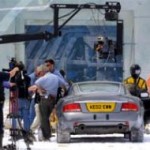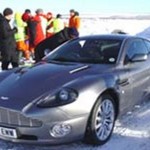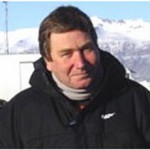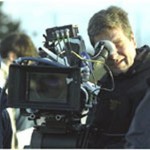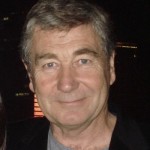As stunt co-ordinator, he’s been involved in the real action in 007’s life for nearly 40 years. And Vic Armstrong is still hellbent on scaring the living daylights out of us.
Report: Richard Girling
Vic Armstrong is not a small man. Sixteen stone if he’s an ounce. In his caravan next to the 007 stage at Pinewood, he sprawls muddily like a farmer, big limbs hogging the space. Not a rough diamond, exactly, but one of those big-softie tough nuts whose hard edges are upholstered with sensitivity. You know without asking that he loves animals.
Outside it’s like the potato harvest. Mud everywhere; water gathering in pools. On the other side of the stage, beyond the workshops, the backlot is a swamp. Earlier in the movie it stood in for North Korea in a hovercraft chase. Now, despite the mantle of Buckinghamshire ooze, it is a frozen Icelandic lake. An army of men in gumboots and dark-blue anoraks splats through the mire, joining bits of cable together.
Somewhere in the thick of it all, under an umbrella, Pierce Brosnan is doing a bit of business against the backdrop of an ice palace (a different angle would have put him in front of a tropical biosphere). But this is the dull, bread-and-butter stuff – the first unit working with movie stars. The real action – the men’s stuff, the grit and guts of the movie – is back inside the stage. Or it will be once the technicians have reassembled the part of the set that has just deconstructed under a hail of simulated gunfire. It’s waiting for the repair that gives Vic Armstrong a moment to reflect.
Looking at his gumbooted bulk, the last thing you’d take him for would be a jockey – he’d need a suffolk punch to get his heels off the ground, or a dromedary. Yet until he caught a whiff of Richard Todd’s aftershave, that’s exactly what he was: a 10-stone jump-jock. As we speak, he snaps into the VCR a cassette containing the roughly edited rushes from three weeks of filming on a real frozen lake in Iceland. A green Jaguar and a silver Aston Martin partner each other in a complex ice ballet whose serpentine elegance belies the aggression of the rock music that Armstrong has pasted onto the temporary soundtrack. While the camera soars above and around them, the cars spin round icebergs, their tyres like blades leaving clean, carved figures in the powdered snow. First the Jaguar is in front; then the Aston. They pirouette, sashay and glide as if moved by the spirit of Diaghilev. The risk of artiness, however, is blown away by rockets and mortars as the film’s protagonists try again and again to obliterate each other. Let nobody forget: this is a Bond film. Though he must have seen it so many times that he knows every ice crystal, Vic Armstrong – Bond stunt co-ordinator and second unit director – smiles and sways to the dance. But we need to scroll back a bit.
Richard Todd’s aftershave? It is, inevitably, a long story. Armstrong was born in 1946, not far from Pinewood, into a line of Scottish blacksmiths. His father, Robert, was a racehorse trainer whose peripatetic lifestyle involved many changes of school for young Vic, though most of his education was in Worthing. Eleven-plus predictably failed, he left school at 141/2 and, being a natural in the saddle, became his father’s jockey. He won, first time out, in a point-to-point at Winchester, on a horse called Trebor. More significant was that the stable included a number of horses owned by actors, one of whom was Richard Todd. “Like owners do, he’d come down and look at the horses on a Sunday. I can still smell the aftershave. It’s amazing. I didn’t know what aftershave was then. I thought, ‘Wow, how glamorous.'” And it set him thinking.
For a while he got no closer to the cinema than watching Todd’s films, riding his horses and inhaling his scented aura. Then, in 1965, at 19, he got the ride of his life. Another visitor to the stables was a professional stuntman, Jimmy Lodge, who was working for Stanley Donen on the filming of Arabesque. The script called for a horse chase over fences, and Lodge had his eye on a big three-day-eventer owned by Vic. He got the animal but it still left him with a problem. A horse is no use without a rider, and Lodge needed someone who could partner it over some huge jumps and not fall off. “So,” says Armstrong, “I went down to the location at Newport Pagnell. Jimmy doubled for Gregory Peck. I doubled for this other fellow, and we did this chase with helicopters following us and I thought, ‘Wow, this is fantastic.’ Twenty pounds a day! Phenomenal!” After that, with the dramatic certainty of an action movie, the story gathers pace.
Another film with Gregory Peck, this time in Switzerland, was followed by television work in London, by which time – in 1966 – stuntmen were needed for the fifth Bond movie, You Only Live Twice. “I went and met Bob Simmons, the stunt co-ordinator, and his assistant George Leech, who, funnily enough, is now my father-in-law. They’d built this huge volcano, 125ft high, and they said, ‘We want people to slide down ropes firing a gun. Can you do that?’ I said yeah, though I never dreamt I could.” The gamble paid off, he was hired at Pounds 65 a week and remains modestly proud of having been the first ninja down the rope. During a break in filming he rode in a selling chase at Sandown at a weight of 10st 3lb, but already he knew that the bigger winnings lay elsewhere. “I was young,” he says, “very fit and agile. I could drive cars, I could drive trucks, I could drive motorcycles, I could jump, run, swim, you know. You’d go for auditions and obviously if you’re young and you line up against three or four older, more portly guys like I am now, they’ll go for the younger one. So I was very lucky. I got a lot of movies very early on.” So many that now, with visitors’ knuckles rapping on the caravan door, and a mobile telephone that doesn’t know the meaning of silence, a lot of brow-furrowing goes into the effort of trying to remember them all. “I doubled George Lazenby (in On Her Majesty’s Secret Service), did lots of fights in the ski sequence. God, it’s all foggy. And Young Winston – I did a lot of horse-falling in that.” Horse-falling was the bread, butter and widow-maker of the old-time stuntmen, much more dangerous than rolling a car. “It’s the hardest thing in the business. The poor old cowboys! It takes huge technical ability to time a horse fall. You’ve got to be on the right leg and on the right stride so that when you give your horse the signal he throws himself through the air. Then you’ve got to hold him all the way to the ground, for the safety of the animal as well, so he doesn’t try to get out of it and break a leg. More often than not he turns over, and more often than not he’s on top of you.” Which is why, he says, 99% of his injuries – which include a broken shin – have been inflicted by horses.
After that, putting on cape and tights for the flying sequences in Superman was like a trip to the fairground – though in gravitational terms what the audience saw was the precise opposite of what actually happened. “Flying up through the roof of Grand Central Station doesn’t sound much,” he says, “because everyone thinks it’s on wires. But in fact we shot it upside down. We used one of the stages here at Pinewood and took the floor out – there’s a pit underneath – and we built the ceiling upside down in its place. Then they’d take me up into the roof and hang me by my ankles. I’d get into the Superman pose, then they’d let me go and I’d ‘fly’ through the roof.” And so it went on: falls, fights, flights, crashes. Wherever a star needed protection from a bruising (including the two Bond grandees, Connery and Moore), there would be Vic Armstrong.
Increasingly, too, he was to be found behind the camera as well as in front of it. With each new film came new responsibilities. The stunt rider in Arabesque became horse-master in Billy Two Hats; the stuntman in You Only Live Twice became stunt co-ordinator in Superman and second-unit director in Bear Island. As a physical daredevil, his final flourish was the Indiana Jones trilogy, in which he doubled for Harrison Ford – Indiana Jones’s Last Crusade in a sense was his own too. But the stuntman’s dying fall was the action director’s launch pad.
Armstrong’s mastery of the honest, old-fashioned, value-for-money action sequence has earned him credits in, among many others, Tomorrow Never Dies, Gangs of New York, The Four Feathers, Captain Corelli’s Mandolin – and, earlier this year, with some 250 films under his belt, a Bafta for his outstanding contribution to cinema.
In fact, there are two kinds of movie stunt. There is the real kind – falling off horses, crashing cars – where the stuntmen actually do what they appear to do on screen, and those where technology deceives the eye into believing it has seen something it hasn’t. As film technology has advanced, so the balance has swung from naked daredevilry to the calculated special effect and carefully contrived action sequence. Cameras are under-cranked to accelerate the action when the film is run at normal speed. Disjointed scraps of stop-start action, each one no more than a few seconds long, are spliced together to create long sequences of apparently reckless action at breakneck speed.
Armstrong’s style, though lacking nothing in technical virtuosity, is surprisingly low on virtual reality and surprisingly high on what Tom Wolfe would call “the right stuff”. Where there is trickery, it tends to be created by the old-fashioned, horny-handed disciplines of engineering, not soft-option computer simulation. There are real drivers in real cars on real ice. One of them, indeed, crashed a very real Aston Martin into a very real iceberg and turned it into a very real pile of very expensive junk. In the caravan, the mobile rings again and yet another fist is hammering at the door. On the phone is a problem, swiftly dealt with – someone, for some reason, has booked some acrobats who now need somewhere to rehearse. At the door is a messenger from the stage, warmly greeted. Good news. The repairs are done. Armstrong can set the cameras rolling again and get on with what he likes doing best: putting the action into a Bond movie. For anyone who hasn’t seen one, a film “stage” is as complete a misnomer as an industry rooted in deception can contrive. Do not visualise a raised platform with curtains and proscenium. Visualise, rather, an airship hangar. It is into this vast empty space, or, rather, into the “ice palace” that has been slotted inside it, that Bond and his murderous pursuer, Zao, have crashed from the frozen lake. Bond’s challenge is to (a) rescue Halle Berry, (b) avoid being topped by Zao, and (c) get out again before the ice palace, which by now is under attack by laser from outer space, melts and sinks into the lake.
For the sake of verisimilitude, the set builders have done everything except use real ice. The palace, as palaces do, has a huge vaulted hall of baroque extravagance. Vast columns reach into the roof. Portentous statues raise echoes of ancient Greece. Corridors and galleries are connected by massive staircases. Here is evil expressed as megalomania, a living mausoleum dedicated to himself by a man whose ambitions are as overblown as his architecture. Pure Bond. And it’s all here in every detail, so exact that Armstrong can point a camera anywhere he likes and the illusion will never slip. The only deception – as effective to the naked eye as it is to the camera – is the substitution of cunningly tinted and textured plastic for ice, but so realistic that one’s ungloved fingers hesitate to touch.
More men in dark-blue anoraks stand around in clumps, like passengers trapped in an airport, slumped in the resigned posture of endless waiting. There are firemen; a man with a squeegee cleaning scum from a pool; a couple of parked cars and a shaven-headed chap in fancy dress with diamond-encrusted cheeks who looks as if he might have got lost on the way to The Rocky Horror Picture Show. The clumps disperse and re-form as Armstrong appears, sloshing through the inch of water that lies underfoot everywhere. This is not seepage from the swamp outside: the stench of chlorine tells you that this is water with a purpose, and the anxiety of those not actively involved to seek shelter in out-of-shot archways gives a fair indication of what the purpose might be. When the two cars, a Jaguar and an Aston, fire their engines, the noise is appalling.
Someone may have called “Quiet please,” or “Action,” but it’s impossible to tell as simultaneous aural and watery hells break loose. From the roof comes a deluge of water – the melting ice – that smacks the floor with the ferocity of a cloudburst. The cars’ exhaust notes rise from howling baritone to shrieking descant; there is an enormous, heart-stopping explosion – some kind of pyrotechnics, simulating gunfire – a squeal of tormented rubber, and then everything subsides again. Through the streaming water it has been possible to see that one of the cars has made a partial circuit of the palace’s orbital outer corridor, while the other has plunged down the stairs and halted.
Behind the wheel of the Jaguar is the Rocky Horror baldie; in the Aston is a shortish chap in body-hugging black, topped off with a glossy black wig. The whole burst of action has taken about three seconds. There is a huddle around the monitors, and then they’re off again. It’s much the same, except this time the Aston is bucking its way up the stairs, its bouncing bodywork skimming each tread with a clearance of millimetres. At the top, its Bond-wigged driver does a bit of business with the handbrake, the tail swings anticlockwise through 90 degrees, and everything stops again. Then they go a second time; then a third. The diamond-faced villain, meanwhile, is out of his car and signalling to his mate like a traffic cop. Eventually they get it bang on; the cameras roll for another three seconds and everyone goes off for lunch. They’ll go on like this for four whole weeks: lining up the cars; gunning them up and down stairs; fishtailing round corners; even (with the help of a concealed winch) reversing up the wall, like a dance sequence filmed step by step- and all in a bucketing monsoon drilled by gunfire. End product: 21/2 minutes of nonstop, high-octane action you could be fooled into thinking had been filmed in real time, and at speeds well in excess of the 20mph actually registered on Armstrong’s radar gun. “The thing is,” he says, “you’re in narrow corridors and going round corners and down steps, so it’s not going to be high speed. It’ll look like the BMW in the car park in Tomorrow Never Dies – remember that one? There was a lot of under-cranking in that, because the guy’s driving completely blind. He’s lying on his back on the floor of the car, just looking at three video screens, so he had to keep the speeds down. I under-cranked and did a lot of foreground strobing to speed it up.” With the current sequence, the obvious problem is to contain a car chase within the tight confines of an elaborate building. In effect, the only way it could work was for the chase to be sketched out first and for the architecture to be designed around it.
The start point was – where else? – the Pinewood backlot, where Jaguar and Aston were powered through corners on full lock, pivoted on their handbrakes, twitched and spun until Armstrong had tested and measured every movement they were capable of. The measurements, including braking distances, banking for the turns and the depth of stair treads, were fed to the set designers, and the result is what we see: a course the cars can get round, but only just. This is crucial. If the drivers could actually steer through the corners, with rear wheels tracking the front, the result would look like a go-kart race, which, says Armstrong, “gets a little bit boring and looks easy”. For this reason, the corners are tighter than full lock, “so the guys have to put the power on to accelerate and get the arse-end flying out on a bit of a fishtail”. Even then, there have to be adjustments. “Some of the turns are narrower than I wanted,” he says, “because even after you’ve designed the set, things suddenly appear. You think, ‘Where’s that come from? That was never in the drawings.'” For this reason, he insisted on a two-week buffer between set construction and filming, so obstructions could be cut out and replaced with soft materials designed to disintegrate on impact. Not the least of his concerns was the safety of cameramen, whose risk of injury when machinery is flying about is rather higher than the drivers’. It took four Jaguars and four Astons, cut up and reassembled in varying states of trim, including the addition of four-wheel drive, to portray the two you will see on screen. The lake in Iceland had to be dammed to accelerate the formation of ice; boats had to be chartered to ferry in the cars and tents, plus a Boeing 757 for the 150-strong crew. And all in pursuit of what, in Armstrong’s mind, is the key ingredient of any Bond stunt: originality. In the car chase you get a triple helping. Putting real cars on real ice; using high-powered models in an environment that could hardly be less suitable for them; and switching the chase indoors. He had pulled a similar trick for the motorcycle chase in Tomorrow Never Dies. Where most directors would have gone for a trials bike with wide handlebars and knobbly tyres, purpose-built for steep ascents and jumps, Armstrong chose a gigantic highway cruiser, a 1600cc BMW. “It obviously creates problems because it’s not good in that environment, but at the same time I think there’s more interest in it.” The same goes for an Aston Martin V12 Vanquish on a frozen Icelandic lake. Stunt work is one of those rare environments in which the obvious answer is rarely the best one. It is also a small and close world, circus-like in its reliance on dynasties.
Armstrong met his wife, Wendy – herself the daughter of George Leech, with whom he worked on You Only Live Twice – on the set of Superman, where she doubled for Lois Lane alongside his own caped crusader. In Tomorrow Never Dies, it was Wendy who sat in for Michelle Yeoh on the back of the lurching BMW. Their daughter, Nina, is also a stuntwoman (directed by her father in The Fourth Angel) and both their sons are among Die Another Day’s small army of technical and engineering wizards. The whole thing has a family feel, like a troupe of travelling showmen. The camera crew is the same he’s had since way back. “The same drivers,” he says, “the same props and everybody, the same grips.” But the knuckles are at the door again. Phones bleep. Engines roar. For another Bond villain, nemesis nudges three seconds closer.
Curtesy of The Sunday Times October 2002
Richard Girling
© Richard Girling/The Sunday Times, London, 2002

